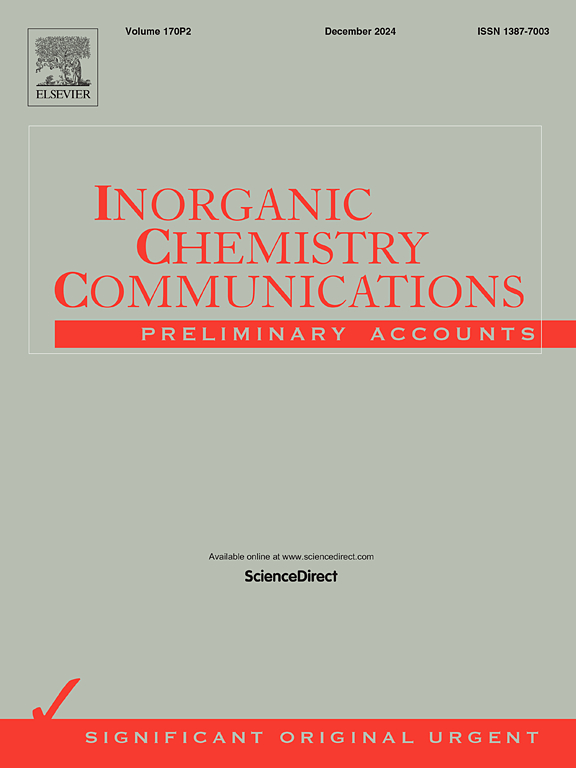Highly sensitive photoelectrochemical sensor for carbohydrate antigen 19-9 detection based on cauliflower heterostructure of NiS@Ni3S2/RGO/CdS composite
IF 4.4
3区 化学
Q1 CHEMISTRY, INORGANIC & NUCLEAR
引用次数: 0
Abstract
The Photoactive materials with typical heterostructure and multi component have been proved that significant photoelectrochemical (PEC) performance. Herein, both microspheric NiS@Ni3S2/RGO/CdS(1 ∼ 2) heterojunction composites were synthesized through the solvothermal and oil-bath reflux method using Ni(btc) as MOFs precursor. Under illumination, PEC experiments showed the structured materials with superior photocurrent response than the NiS@Ni3S2 and CdS(1). It was ascribe to facts that the formed p-n type heterostructure between NiS and CdS markedly accelerating the transfer of charge carriers, every component in NiS@Ni3S2/RGO/CdS(1 ∼ 2) with well-synergistic effect was beneficial to improve the co-catalytic activities on the heterogeneous interface and relatively enhanced the photoelectric conversion efficiency. Besides, RGO as high electrical conductor could promote photo-generated electrons transport. Based on the outstanding photoelectric property of NiS@Ni3S2/RGO/CdS(1) to fabricate the PEC sensing platform (BSA/Ab/GLA-CS/NiS@Ni3S2/RGO/CdS(1)/ITO) displaying highly analysis sensitivity for carbohydrate antigen 19-9 (CA19-9), the wider linear range (0.001 ∼ 54 U⋅mL−1) and low detection limit (0.41 mU⋅mL−1) were achieved. The proposed PEC biosensor also had good selectivity and satisfying stability. This elaborately design of p-n heterostructure with multi-components should be great prospective for the photocatalysis or constructing the other PEC biosensor.

基于NiS@Ni3S2/RGO/CdS复合材料花椰菜异质结构的高灵敏度碳水化合物抗原19-9检测光电传感器
具有典型异质结构和多组分的光活性材料已被证明具有显著的光电化学性能。本文以Ni(btc)为mof前驱体,采用溶剂热法和油浴回流法合成了NiS@Ni3S2/RGO/CdS(1 ~ 2)异质结复合材料。在光照下,PEC实验表明结构材料比NiS@Ni3S2和CdS具有更好的光电流响应(1)。这是由于NiS和CdS之间形成的p-n型异质结构明显加速了载流子的转移,NiS@Ni3S2/RGO/CdS(1 ~ 2)中各组分具有良好的协同作用,有利于提高异质界面上的共催化活性,相对提高了光电转换效率。此外,RGO作为高导电体可以促进光生电子输运。利用NiS@Ni3S2/RGO/CdS(1)优异的光电特性制备的PEC传感平台(BSA/Ab/GLA-CS/NiS@Ni3S2/RGO/CdS(1)/ITO)对碳水化合物抗原19-9 (CA19-9)具有较高的分析灵敏度,实现了较宽的线性范围(0.001 ~ 54 U⋅mL−1)和较低的检出限(0.41 mU⋅mL−1)。PEC生物传感器具有良好的选择性和良好的稳定性。这种精心设计的多组分p-n异质结构在光催化或构建其他PEC生物传感器方面具有很大的前景。
本文章由计算机程序翻译,如有差异,请以英文原文为准。
求助全文
约1分钟内获得全文
求助全文
来源期刊

Inorganic Chemistry Communications
化学-无机化学与核化学
CiteScore
5.50
自引率
7.90%
发文量
1013
审稿时长
53 days
期刊介绍:
Launched in January 1998, Inorganic Chemistry Communications is an international journal dedicated to the rapid publication of short communications in the major areas of inorganic, organometallic and supramolecular chemistry. Topics include synthetic and reaction chemistry, kinetics and mechanisms of reactions, bioinorganic chemistry, photochemistry and the use of metal and organometallic compounds in stoichiometric and catalytic synthesis or organic compounds.
 求助内容:
求助内容: 应助结果提醒方式:
应助结果提醒方式:


